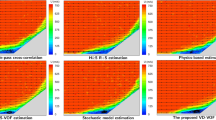Abstract
Data reduction algorithms for flow tagging velocity measurements are presented. Laser induced photochemical anemometry (LIPA) is the flow tagging technique used for the current experiments. This technique yields temporally and spatially resolved velocity and vorticity information. LIPA is first demonstrated in a laminar boundary layer. More complicated applications include a laminar boundary layer interacting with a flush-mounted, rotating disc, as well as a shear wake interaction with a circular cylinder. Advancements of the current study include the use of improved photoluminescent chemicals, as well as implementation of accurate image processing/data reduction algorithms. These yield typical errors in the instantaneous velocity data of less than 4%.
Similar content being viewed by others
References
Baker CJ (1979) The laminar horseshoe vortex. J Fluid Mech 95: 347
Barlow RS; Johnston JP (1985) Structure of turbulent boundary layers on a concave surface. PhD Dissertation, Stanford University, Stanford, CA
Chu CC; Falco RE (1988) Vortex ring/viscous wall layer interaction model of the turbulence production process near walls. Exp Fluids 6: 305
Chu CC; Liao YY (1992) A quantitative study of the flow around an impulsively started cylinder. Exp Fluids 13: 137
Falco RE; Chu CC (1987) Measurement of two-dimensional fluid dynamic quantities using a photochromic grid tracing technique. SPIE 814: 706
Gendrich CP; Koochesfahani MM; Nocera DG (1994) Analysis on molecular tagging velocimetry images for obtaining simultaneous multi-point velocity vectors. Bull Am Phy Soc 39: 1980
Goldfish LH; Koutsky JA; Adler RJ (1965) Chem Engng Sci pp. 1011
Karman T von (1921) Über laminare und turbulente reigung. Z Agnew Math Mech 1: 233–252 (trans. as NACA Tech Mem 1092)
Kim J; Moin P; Moser R (1987) Turbulence statistics in fully developed channel flow at low Reynolds number. J Fluid Mech 177: 133
Klewicki JC (1989) On the interaction between the inner and outer region motions in turbulent boundary layers. PhD Dissertation, Michigan State University, East Lansing, MI
Klewicki JC; Hill RB (1994) Influences of near-wall ω y on coherent vortex formation. Submitted to ASME Fluids Eng Div Summer Meeting Proceedings, Symp. on Turbulence Control
Lee K (1994) Shear wake interactions with a circular cylinder. PhD Dissertation, University of Utah, Salt Lake City, UT
Lempert W (1992) Private Communication
Miles R; Cohen C; Conners J; Howard P; Huang S; Markovitz E; Russel G (1987) Velocity measurements by vibrational tagging and fluorescent probing of oxygen. Optics Lett 12: 861
Miles RB; Zhou D; Zhang B; Lempert WR; She ZS (1993) Fundamental turbulence measurements by relief flow tagging. AIAA J 31: 447
Miller S (1962) Photochemical reaction for the study of velocity patterns and profiles. BASc Thesis, University of Toronto
Ojha M; Cobbold RSC; Johnston KW; Hummel RL (1989) Pulsatile flow through constricted tubes: an experimental investigation using photochromic tracer methods. J Fluid Mech 203: 173
Ponce A; Wong PA; Way JJ; Nocera DG (1993) Intense phosphorescence triggered by alcohols upon formation of a cyclodextrin ternary complex. J Phys Chem 97: 1137
Popovich AT (1969) Statistical analysis of fluid flow fluctuations in the viscous layer near a solid surface. Ind Engng Chem Fundls 8: 609.
Popovich AT; Hummel RL (1967) A new method for non-disturbing turbulent flow measurement very close to a wall. Chem Engng Sci 22: 21
Popovich AT; Lavallee HC (1970) Flow conditions near roughness elements obtained by photolysis method. Chem Engng Sci 25: 1109
Seeley LE; Hummel RL; Smith JW (1975) Experimental velocity profiles in laminar flow around spheres at intermediate Reynolds numbers. J Fluid Mech 68: 591
Taylor JR (1982) An Introduction to Error Analysis. University Science Books, Mill Valley, CA
Author information
Authors and Affiliations
Additional information
This work supported by the National Science Foundation under grant No. CTS-9120076.
Rights and permissions
About this article
Cite this article
Hill, R.B., Klewicki, J.C. Data reduction methods for flow tagging velocity measurements. Experiments in Fluids 20, 142–152 (1996). https://doi.org/10.1007/BF00190270
Received:
Accepted:
Issue Date:
DOI: https://doi.org/10.1007/BF00190270




